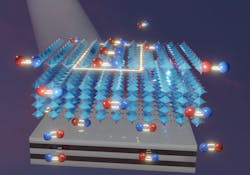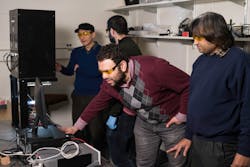Perovskites show tremendous promise as a less expensive, equally efficient alternative to silicon for solar cells and detectors—and they’re about to get even more efficient.
Typically, perovskites are synthesized in a wet lab, and then applied as a film onto a glass substrate. But by using an approach that involves placing a metal platform under a perovskite, Chunlei Guo, a professor of optics, and his team discovered they can increase perovskites’ light conversion efficiency by 250%.
The metal platform can be a substrate of either one layer of metal or a metamaterial of alternating layers of dielectric materials—and it changes the interaction of the electrons within the perovskite.
This purely physical interaction allows Guo’s team to tailor perovskite’s material properties, and it can also be applied to other materials.
“My lab is working on instilling simple materials with more complex functionalities,” explains Guo. “We introduced a range of purely physical/laser technologies to transform simple metals to pitch black, superhydrophilic (water attracting) or superhydrophobic (water repellent) materials. And we wanted to see if we could enhance more complex materials through physical ways, and it led us to this discovery.”
Perovskite-metal pairing
In a solar cell, photons from sunlight excite electrons and pull them away from their atomic cores to generate an electrical current.It results in a significant reduction of electron recombination because the metal layer essentially acts as a mirror, which creates reversed images of electron-hole pairs and weakens the ability of electrons to recombine with holes.
“What we’ve achieved is quite counterintuitive: By carefully pairing a perovskite and a metallic platform, we drastically slow the recombination process,” he says. “This effect hadn’t been recognized in perovskites until now.”
The most surprising aspect of this work is simply the ability to control a semiconductor’s properties “via a purely physical method rather than by chemical engineering,” Guo says.
Future solar energy harvesting?
To bring their technology to fruition, the team has worked through a lot of difficult physics problems—and it may play a role in future energy harvesting.
“At this point, we have a good grasp on the fundamental physics involved,” says Guo. “But the perovskite as a solar material faces its own challenges, mainly long-term stability, before it can be widely adopted in real-world use.”
And as far as applications, the team’s physical method can be applied to a wide range of optoelectronic devices, such as solar cells and detectors. “We believe we’ll see a considerable growth of perovskites in the solar market within the next few years,” he adds.
Next, the team plans to further optimize the plasmonic and metamaterial platforms to enhance the perovskite performance. “The field of perovskites is a very active research area today and new materials continue to emerge,” says Guo. “As new perovskites are developed, we want to apply our technology to them and benefit from their performance.”
FURTHER READING
K. J. Lee et al., Nat. Photon. (2023); https://doi.org/10.1038/s41566-022-01151-3.



